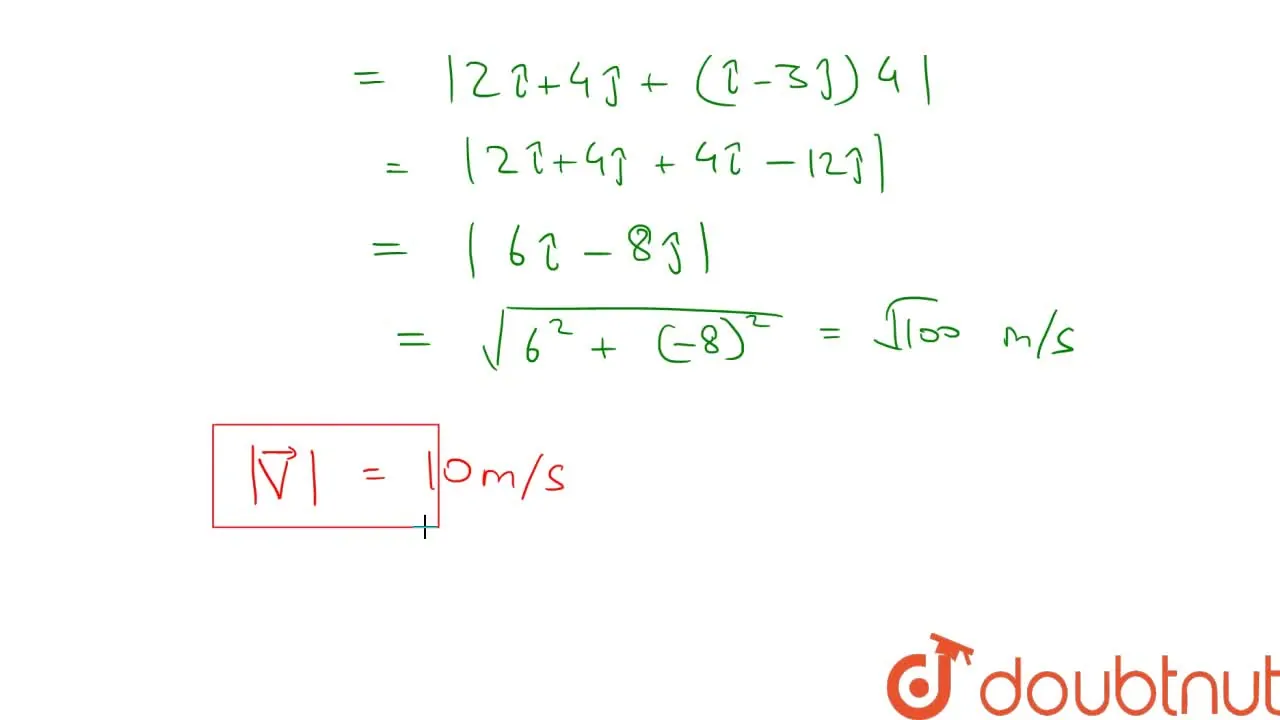An object has a velocity, v=(2ˆi+4ˆj)ms−1 at time t=0s. It undergoes a constant acceleration a=(ˆi−3ˆj)ms−2 for 4s. Then
(i) Find the coordinates of the object if it is at origin at t=0
(ii) Find the magnitude of its velocity at the end of 4s.
(i) Here initial position of the object
r0=x0ˆi+y0ˆj+0ˆi+0ˆj
Initial velocity, v0=v0xˆi+v0yˆj=2ˆi+4ˆj
Acceleration a=axˆi+ayˆj=ˆi−3ˆk
And t=4s
Let the final coordinates of the object be (x,y),. Then according to the equation for the path of particle under constant acceleration.
x=x0+v0xt+12axt2
=0+2×4+12(1)×42
⇒x=16cm
and y=y0+v0yt+12ayt2
=0+4×4+12(−3)×42
→y=−8m
Therefore the object lies at (16ˆi−8ˆj) at t=4s.
(ii) Using equation
v=v0+at
⇒v=(2ˆi+4ˆj)+(ˆi−3ˆj)×4
=(2ˆi+4ˆj)+(4ˆi−12ˆj)=(2+4)ˆi+(4−12)ˆj
⇒v=6ˆi−8ˆj
∴ Magnitude of velocity, |v|=√62+82=10ms−1
Its direction with X-aixs θ=tan−1(−86)≈−53∘
Related Playlists
- BOOK - DC PANDEY ENGLISHCHAPTER - MOTIONEXERCISE - Check Point 4.115videos
MOTION
- BOOK - DC PANDEY ENGLISHCHAPTER - MOTIONEXERCISE - Check Point 4.220videos
MOTION
- BOOK - DC PANDEY ENGLISHCHAPTER - MEASUREMENT AND ERRORSEXERCISE - Subjective19videos
MEASUREMENT AND ERRORS
- BOOK - DC PANDEY ENGLISHCHAPTER - MOTION IN A PLANEEXERCISE - (C )Medical entrances gallery32videos
MOTION IN A PLANE
Similar Questions
A particle starts from the origin at t = 0 s with a velocity of 10.0ˆj m/s and moves in plane with a constant acceleration of (8ˆi+2ˆj)ms−2. The y-coordinate of the particle in 2 sec is
View SolutionA particle's velocity changes from (2ˆI+3ˆj)ms−1 in to (3ˆi−2ˆj)ms−1 in 2s. Its average acceleration in ms−2 is
View SolutionThe velocity of an object at t =0 is →v0=−4ˆj m/s . It moves in plane with constant acceleration →a=(3ˆi+8ˆj)m/s2. What is its velocity after 1 s?
View SolutionA particle velocity changes from (2ˆi−3ˆj)ms−1 to (3ˆi−2ˆj)ms−1 in 2s. If its mass is 1kg, the acceleraton (ms−2) is
View SolutionA particle starts from the origin at t=Os with a velocity of 10.0ˆjm/s and moves in the xy-plane with a constant acceleration of (8ˆi+2ˆj)m/s−2. What time is the x-coordinate of the particle 16m?
View SolutionA particle starts from origin at t=0 with a velocity of 15ˆims−1 and moves in xy-plane under the action of a force which produces a constant acceleration of 15ˆi+20ˆjms−2. Find the y-coordinate of the particle at the instant its x-coordinate is 180 m.
View SolutionVelocity of a particle at time t=0 is 2ˆi m/s. A constant acceleration of 2ms2 acts on the particle for 2s at an angle of 60∘ with its initial velocity. Find the magnitude of velocity and displacement of particle at the end of t=2s.
View SolutionA particle P is at the origin starts with velocity u=(2ˆi−4ˆj)m/s with constant acceleration (3ˆi+5ˆj)m/s2. After travelling for 2s its distance from the origin is
View SolutionThe position of an object is given by →r=(9tˆi+4t3ˆj) m. find its velocity at time t= 1s.
View SolutionVelocity of particle at time t=0 is 2ms−1.A constant acceleration of 2ms−2 act on the particle for 1 second at an angle of 60∘ with its initial velocity .Find the magnitude velocity and displacement of the particle at the end of t=1s.
View Solution


